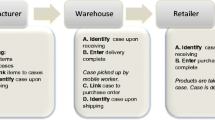Abstract
Identification plays an important role in automation. In the near future radio frequency identification (RFID) will be an option for mass production automation projects. RFID represents a contactless method for data transfer in object identification. Generally, RFID systems consists of three components: 1. A small electronic data carrying device called a transponder, or a tag that is attached to the item to be identified. 2. A reader or a scanner that communicates with the tag by using radio frequency signals. 3. A host data processing system that contains information on the identified item and distributes information to other remote data processing systems. An RFID system can be considered as a wireless communication system because the scanner communicates with the tag by using electromagnetic waves at radio frequencies. The performance of this communication link can be studied by determining the read range for backscatter RFID systems. The read range, or the distance at which the reader unit notices the tag, depends on many factors. Several parameters, e.g. the frequency used for identification, the gain, the orientation and the polarisation of the reader antenna and the transponder antenna, and the placement of the tag on the object to be identified, will all have an impact on the RFID system read range. In this paper, Part 1, we focus on presenting an overview of different passive RFID systems and the read range of the backscatter RFID system. The function of frequency, antenna gain and polarisation mismatch are analysed and discussed. In Part 2, several manufacturing automation cases of different natures will be presented. These cases contain a selection of requirements for an RFID system and they are analysed using the information presented in this paper.
Similar content being viewed by others
Author information
Authors and Affiliations
Corresponding author
Rights and permissions
About this article
Cite this article
Keskilammi, M., Sydänheimo, L. & Kivikoski, M. Radio Frequency Technology for Automated Manufacturing and Logistics Control. Part 1: Passive RFID Systems and the Effects of Antenna Parameters on Operational Distance . Int. Journ. Adv. Manufac. Tech. 21, 769–774 (2003). https://doi.org/10.1007/s00170-002-1392-1
Issue Date:
DOI: https://doi.org/10.1007/s00170-002-1392-1




